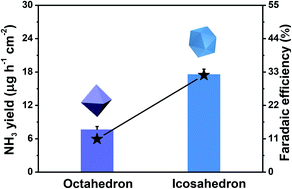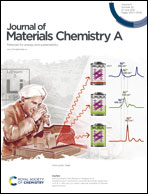The twinned Pd nanocatalyst exhibits sustainable NRR electrocatalytic performance by promoting the desorption of NH3†
Abstract
As ammonia is an important chemical raw material, a lot of efforts have been made in the field of electrochemical nitrogen reduction (NRR) to promote artificial nitrogen fixation. At present, research on NRR is widely focused on improving the catalyst's adsorption and activation of N2. However, it has not yet been studied how to promote the desorption of NH3 by the catalyst to obtain continuous and stable catalytic activity. Herein, we synthesized Pd octahedrons and icosahedrons with similar sizes and studied the role of twins in NRR for the first time. At −0.2 V vs. RHE, the Pd icosahedron achieved a high NH3 yield and FE, which were 17.56 μg h−1 cm−2 (43.9 μg h−1 mgcat.−1) and 31.98%, respectively. After 200 h of electrolysis, the NH3 yield of Pd icosahedrons did not significantly decrease, which maintained excellent catalytic stability. Its performance is better than other catalysts that have been reported. In situ FTIR measurements and DFT calculation proved that due to the existence of the twin structure, the energy required for the potential-determining step and the NH3 desorption step of the Pd catalyst is greatly reduced. Accelerating the desorption of NH3 improves the utilization of active sites due to which the Pd icosahedron maintains continuous excellent catalytic activity. This provides a new direction for the design of catalysts to improve their NRR performance.



 Please wait while we load your content...
Please wait while we load your content...